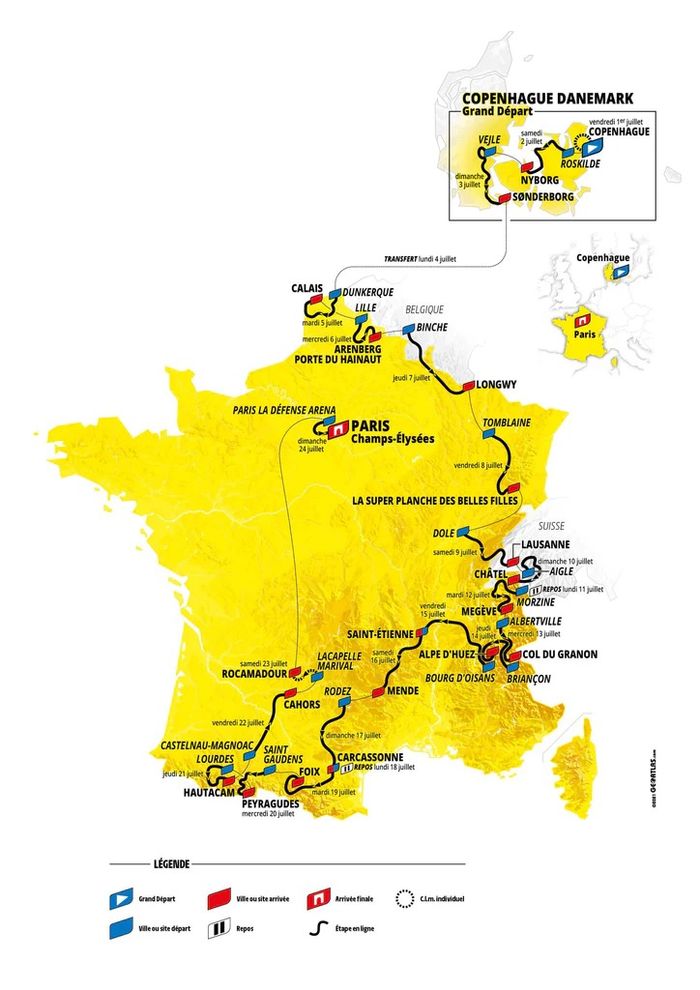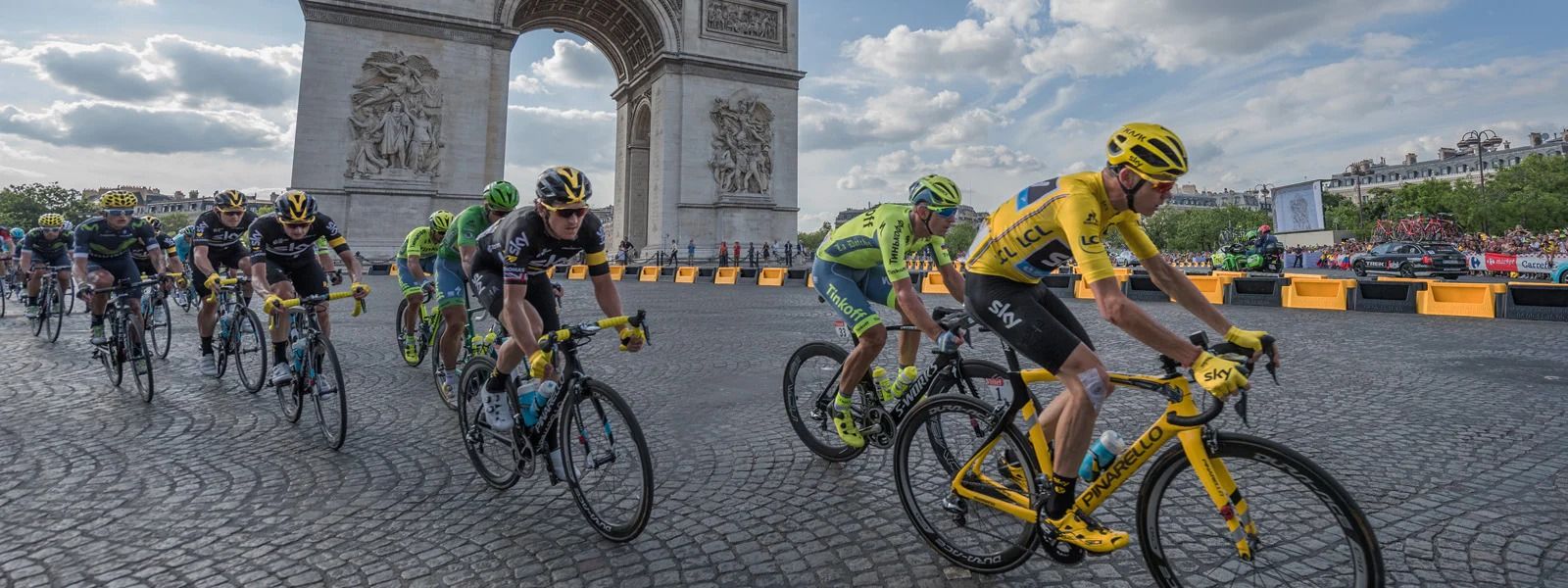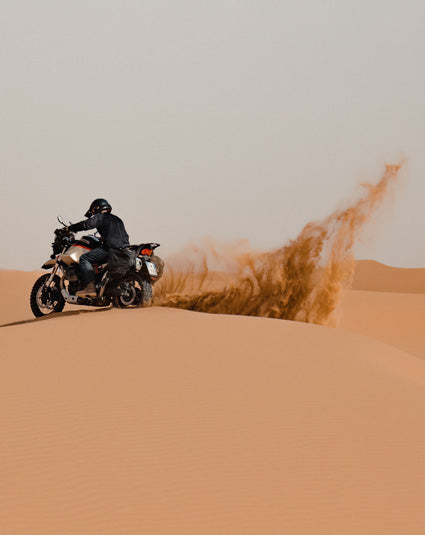The world’s biggest annual sporting event, the Tour de France, is about to get underway. So for those not in the know, we’ve gathered some key information to get you up-to-speed with everything you need to know.
What Is The Tour De France?
The Tour de France is a multi-day cycling event, consisting of 21 stages, with the 2022 edition held over 23 days. Each stage is classed as a different category of ride, including individual time trials, flat terrain stages, hilly stages, and mountain stages. Each stage is completed over one day, and this year includes three rest days in between (typically there are only two rest days). Which might come as a relief for some riders!
The Tour follows routes through France and surrounding countries, with the final leg finishing at the Champs-Élysées in Paris. Each stage (or day) of riding generally covers between 150km-200km (90mi-125mi) of riding, often climbing over 1000 vertical metres (3280 vertical feet), as well as two shorter time trial stages.
The name isn’t completely accurate though as this year’s Tour de France actually begins in Copenhagen, Denmark. It will cover a total of 3,328 km (2,068 mi) over the 21 stages, travelling through four countries including Denmark, Belgium, Switzerland and, of course, France.
What Teams Ride In The Tour?
The Tour de France invites teams to enter based on their rankings in the UCI (Union Cycliste Internationale, the world cycling governing body), sometimes also inviting some wild card teams to compete. Pro cyclists will be signed to teams, and depending on their performance during the racing season, they will be named on the team roster for the Tour.
Teams are from a particular country, however the riders in the team are not necessarily from the same country as the team, or even from the same country as each other.
Teammates work to assist one another and put their leading rider in the best position, ensuring they can make a break when needed, or have morale or technical support should they make a breakaway from the main group and run into trouble without their support vehicle able to reach them easily.
How Do The Stages Work?
The Tour generally consists of 22 teams (but may include slightly more or less), with up to 8 riders per team. The 2022 Tour includes 22 teams, with 8 riders per team, which gives a total of 176 riders. Not all riders will be trying to lead in any of the classifications, as they ride in teams, many of the cyclists in the Tour are there to support their team and ensure that the leader of their team is in the best position to win the classification they are most capable of winning.
Each stage, cyclists compete to lead the General Classification, Points Classification, Mountains Classification, Young Rider Classification, Team Classification and Combativity Award.
Time Trial Stages
The first stage of this year's Tour is a Time Trial stage. Each rider starts two minutes apart and races against the clock.
Riders wear special aero-dynamic kit (cycling clothing), ride specific Time Trial bikes (also known as TT bikes) which are built to be light and fast, and wear aerodynamic helmets. If you hadn't guessed yet, the aim of the time trial is to be light and fast.
The challenges of time trials are to maintain as quick a pace as possible, which gets technical during cornering as riders must determine exactly how little they need to drop speed while still safely navigate any bends in the road.
Mass-Start Stages
Mass-start stages simply refer to the non-time trial stages, where all the riders being the race at the same time. Mass-start stages have multiple pre-determined way points in which riders looking to lead the Points and Mountains Classifications will be wanting to cross first.
This is where you will sometimes see riders make a quick sprint to pass a checkpoint during a stage. More points are awarded based on the Classification they are for, with flat finishes and waypoints rewarding more for Sprinters and summit finishes rewarding higher for Mountains.
Why Are There Different Coloured Jerseys And What Do They Mean?
Each of these jerseys represents a leader in a different classification, and is presented to the leading rider for each classification at the end of every stage, for him to wear the next day in the following stage. It is possible for one cyclist to hold multiple classifications at the same time, and the jersey they will wear at the following stage will be the highest ranking of the classifications they hold.
The Yellow Jersey is the most well known of the classifications. It is awarded at the end of each stage to the rider with the lowest cumulative time, or the rider currently in the lead of the Tour, this is also known as the General Classification (GC).
The Polka Dot Jersey (or white with red spots) represents the cyclist leading the Mountains Classification, also known as King of the Mountains. During each hilly or mountainous section, points are awarded to the cyclist that completes the climb first, with the rider in the lead of the mountains classification wearing the Polka Dot jersey at the following stage.
The Green Jersey represents the leader of the Points Classification. Points are awarded at predetermined points along the stage, as well as at the end of the stage. To favour sprinters for the Green Jersey lead, more points are awarded for flatter finishes and fewer for mountainous.
The White Jersey represents the Young General Classification leader. It follows the same rules as the yellow jersey, but is only awarded to riders below the age of 26. Several riders have led and won both the yellow and white jersey classifications in previous Tours.
Tactics To Win Classifications
Cycling involves plenty of tactics, and support from teammates is often crucial for the success of the winners. Maintaining a consistent speed of on average 40 kmp/h (25 mip/h) for potentially upwards of 200kms (125mi) is no easy feat.
The power of the peloton helps set the pace, with riders at the front regularly swapping out and taking turns to “pull” - take the force of the weather, such as strong winds, and set the pace. Riders behind those at the front can “hop on a wheel” and benefit from the slip stream created, meaning they need to exert less effort to maintain the speed of the group.
Teammates are necessary in these instances, making sure the team leader (or the rider the team are supporting to attempt a stage win or classification win) is in the best position to maintain a challenge for the lead, without needing to exert too much effort, saving their legs for the moment they want to break and win the stage or points.
Teammates also help ensure that their rider is in a good position for any finishes. If a strong rider is not supported by a strong team, or their team is not in the right position for them to push to the lead, it can ruin any chance that rider has of getting to the front of the peloton, making a breakaway, or sprinting to the finish.
Riders may attempt a breakaway, putting distance between themselves and the main peloton. The most successful breakaways will generally include around 16 riders, usually with a few from the same team, and on the mountainous stages of the Tour rather than the flat. The advantage the peloton has over any smaller group of breakaway riders is wind resistance. A tight bunch of riders can reduce wind resistance by up to 97%.
A breakaway of riders on the flat stages becomes virtually impossible (though not entirely impossible) due to the greater role wind plays in affecting speed of the cyclists. On a flat or sprint finish, if the peloton decides to increase the speed the effort required will be far less than smaller groups of riders, who will be also facing more challenge from the wind.
What Does Each Stage Look Like?
Below is a quick rundown of each stage this years Tour, and key stages to look out for.
Stage 1:
Individual time trial. This stage is short, with some technical aspects, and will decide who starts with the Yellow Jersey.
Stage 2:
Flat stage. The most challenging part of this stage will come at the end, when the peloton crosses The Great Belt Bridge. At 18km long and 65m high, wind will be on every riders mind as they ride this stage.
Stage 3:
Flat stage. With three category four climbs amongst a flat route, this will most likely be a sprinters finish.
(Transfer/Rest day)
Stage 4:
Hilly stage. With multiple short category four climbs, this stage is ideal for attacks. We may see some breakaway riders and groups during this stage.
Stage 5:
Hilly stage. This stage will be the most interesting for it's "Roubaix" sections, 11 cobbled sections in the route and smaller roads. This could be another stage for breakaways.
Stage 6:
Hilly stage. Short but some steep climbs, this could be another great stage for riders to attack. A few hills throughout this stage, then 6km (3.7mi) before the finish, riders climb 800m (2,600ft) at an average 12.3% gradient, and 1.6km (1mi) climb up an average 5.8%.
Stage 7:
Mountain stage. Two category three climbs before the first category one climb of the Tour and a summit finish. The final climb of this stage is 7km long, with an average gradient of 8.7%. Your legs will be screaming just watching.
Stage 8:
Hilly stage. With some category three and four climbs, this stage includes big opportunities for breakaway riders and groups to put distance between them and the peloton.
Stage 9:
Mountain stage. The Tour heads into the Alps, starting with a category four climb, before a category two, then two category one climbs to finish the stage. A great day of scenery and tough climbing.
(Rest day)
Stage 10:
Hilly stage. Potential for another breakaway with some category four, three and two climbs this stage.
Stage 11:
Mountain stage. An enormous day of climbing, starting with a category two, then category one, followed by two HC climbs to finish. HC climbs refer to the roughest climbs that are "beyond categorization" (Hors Categorie in French). The term was originally used for mountain roads where cars were not expected to be able to pass. Should be pretty easy for the cyclists then.
Stage 12:
Mountain stage. Another enormous day of climbing, with three HC category climbs, the first of which starting shortly after the first 10km. Sit back and enjoy watching the serious strength and mental resolve these riders have to push themselves through stages such as this one.
Stage 13:
Flat stage. A make or break day for some of the key sprinters looking to lead the General Classification. With minimal climbing this stage, some teams may try to push the pace through the climbs in an attempt to drop sprinters.
Stage 14:
Hilly stage. Another stage that could see some breakaway groups taking advantage of the lower category climbs to put space between them and the peloton.
Stage 15:
Flat stage. Likely to be no lasting breakaways in this stage, with only two category three climbs. This will be a sprinters finish.
(Rest day)
Stage 16:
Hilly stage. With some climbing in the Pyrenees, starting with a couple of easier climbs and finishing off with two category one climbs before a downhill finish.
Stage 17:
Mountain stage. A flat start to the this stage before a category two, and three category one climbs.
Stage 18:
The final mountain stage. Sure to be an exciting watch, which, depending on how the previous stages have gone, could separate the leader of the General Classification from the rest of the bunch and into an easy position for the final stages.
Stage 19:
Flat stage. Sure to be a very fast day, with little climbing involved, this stage will likely see little break from the peloton until the end.
Stage 20:
Time trial stage. A great opportunity for some excitement depending on the General Classification leaderboard, this stage may spice things up before the final day.
Stage 21:
Flat stage. Only one category four climb before the final sprint to finish at the Champs-Élysées and the end of the Tour de France for another year. If you haven't had enough cycling, the first ever Tour de France Femmes begins this same day, and will be another great event to watch!
 The Tour de France 2022 route map.
The Tour de France 2022 route map.
Riders To Look Out For In This Year's Race
Tadej Pogačar looks set to take out his third consecutive Tour win, with all reports putting him well ahead of competition in the lead up to this year's race.
But nothing is certain, so some other riders to look out for as competition for the General Classification include Daniel Martinez, Jonas Vinegaard, Aleksandr Vlasov.
The Sprinters Classification (Green Jersey) may go to seven-time winner Peter Sagan, while other favourites include Wout Van Aert, Mathieu van der Poel, Caleb Ewan, Fabio Jakobsen and Dylan Groenewegen.
The Mountains Classification (Polka Dot Jersey) will likely also go to Tadej Pogačar who has won it the last two Tours, but he may see some competition from Primož Roglic, Aleksandr Vlasov, Jonas Vinegaard, among a few others.
As interesting as the race itself, is the French Countryside and historical locations riders pass through make for very enjoyable watching. So now you’re up-to-speed with The Tour, you can sit back and enjoy it in all its glory. There’ll certainly be some tired eyes here at Quad Lock as we watch on from Australia, given the time difference.








